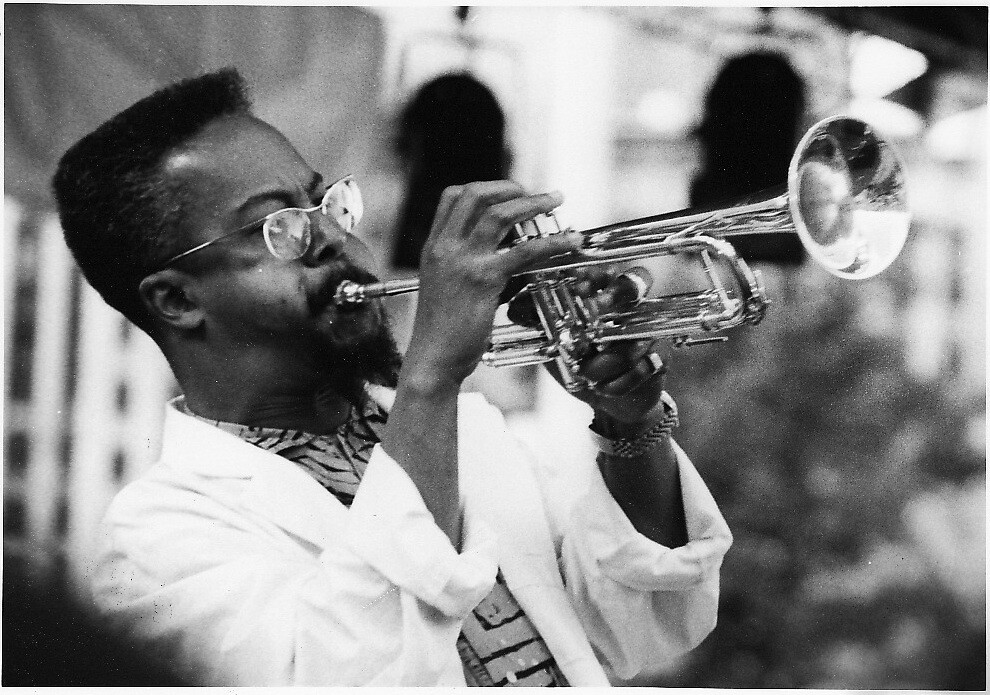
“Lester Bowie” by John Kelin is licensed with CC BY-ND 2.0. To view a copy of this license, visit https://creativecommons.org/licenses/by-nd/2.0/
St. Louis trumpeter Lester Bowie was a traditionalist—and a rebel. His father, grandfather, and uncles all played brass instruments, and he continued the family tradition, taking up the trumpet at the age of five. Soon he was advanced enough to study with a classical trumpeter from the St. Louis Symphony. But when he turned fifteen, Bowie left classical music behind, making his professional debut in bands that played blues and R&B.
Lester Bowie Jr. was born on October 11, 1941, in Frederick, Maryland. He grew up eight hundred miles to the west, in St. Louis, Missouri, where his father Lester Sr. worked as a school band director. After Bowie graduated from high school, he served in the U.S. Air Force, then studied music at Lincoln University and North Texas State. In 1964, he returned to St. Louis and started performing with the city’s best blues and R&B acts, including Little Milton and Oliver Sain. He also married the vocalist Fontella Bass, a fellow member of the Milton and Sain groups. By 1965, Bass’s star was on the rise: she signed a contract with the Chicago-based independent label Chess Records, and her single “Rescue Me” rose all the way to No. 1 on the R&B charts. Bass and Bowie wanted to get “close to the cash,” so they moved from St. Louis to Chicago. The newlyweds had everything they wanted: “a ’51 classic Bentley, a motorcycle, [and] a hip apartment in Chicago.” However, Chess Records soon stopped paying Bass the royalties she was owed, and Bowie became disenchanted with the R&B scene. He began to search for a new musical home—and found one in Chicago’s Association for the Advancement of Creative Musicians (AACM), a collective of African American experimental composers. Through the AACM, Bowie met the saxophonist-composer Roscoe Mitchell, who invited the trumpeter to join his band in 1966. That summer, Mitchell, Bowie, and their bandmates tracked their first album: Sound, a recording that forever changed jazz and experimental music.
There had never been a band like Mitchell and Bowie’s group, which by the late 1960s was known as the Art Ensemble of Chicago. Their performances combined idiosyncratic compositions and telepathic improvisations with costumes, theatrical sketches, and poetry recitations. Bowie’s special contribution to the Art Ensemble was his playing style, a fusion of traditional and avant-garde techniques that made him one of the most distinctive trumpeters since Miles Davis. Bowie also masterminded the band’s business operations (concert tours, recording contracts, merchandise sales), an effort that made the Art Ensemble the rarest of all things—a financially successful avant-garde performing troupe. For thirty-three years, until his death on November 8, 1999, Bowie was the face of the Art Ensemble, playing trumpet at center stage while wearing the white laboratory coat that marked him as the sound scientist in charge of the band’s musical experiments. With the Art Ensemble, the ex-classical, ex-R&B trumpeter could be the tradition-conscious rebel that he was born to be. As Bowie observed, the members of the Art Ensemble were “traditionalists in [a] sense,” because “rebellion is the actual tradition of jazz.”
